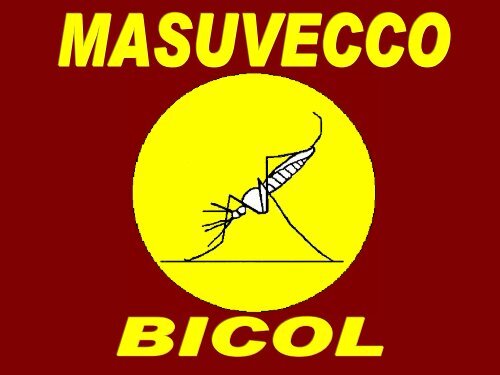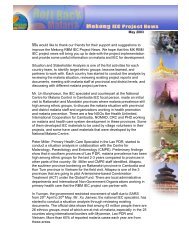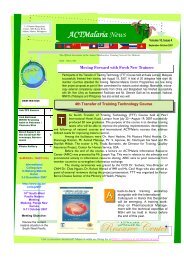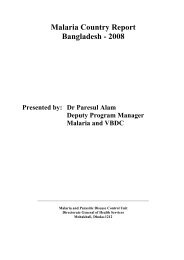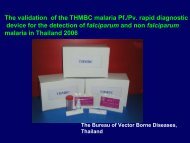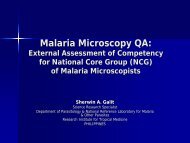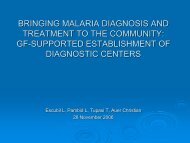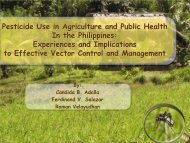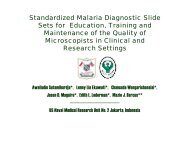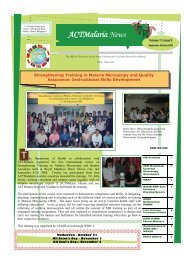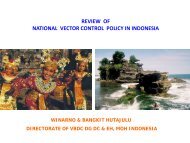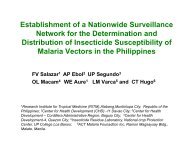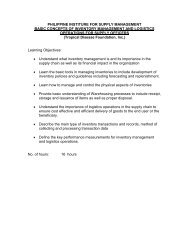Community - Asian Collaborative Training Network for Malaria
Community - Asian Collaborative Training Network for Malaria
Community - Asian Collaborative Training Network for Malaria
Create successful ePaper yourself
Turn your PDF publications into a flip-book with our unique Google optimized e-Paper software.
Objectives of presentation<br />
• To communicate learning<br />
experiences on innovative<br />
approach in malaria<br />
prevention and control<br />
• To illustrate that community<br />
based malaria surveillance<br />
and vector control can be<br />
attained and contribute to<br />
incidence change
• <strong>Malaria</strong> is an antique<br />
disease that affects man<br />
since ancient times<br />
• Worldwide: 300 to 500 M<br />
cases, and 1.5 to 2.7 million<br />
deaths each year…
Concerns on MCP<br />
Only one Rural <strong>Malaria</strong><br />
Coordinator in the<br />
municipality …<br />
* could not cover all endemic<br />
villages to conduct<br />
surveillance, health<br />
education, and vector<br />
control activities
Concerns …<br />
<strong>Community</strong>:<br />
• Poor understanding of<br />
malaria prevention and<br />
control …<br />
* very few households use<br />
bednets (“katol”)<br />
* regard malaria as “Flu”<br />
(do not seek consultation)
• <strong>Community</strong>:<br />
Concerns …<br />
• Far-flung villages<br />
- poor access to services<br />
* self medication, and just<br />
wait until fever subsides<br />
• Transient small-scale miners<br />
(no bednets)<br />
• Presence of ethnic minorities (no<br />
bednets, hammoks and bonfire)
Masbate<br />
.07%(4)<br />
<strong>Malaria</strong> Incidence, Region 5<br />
by province, 1987 (n= 5,521)<br />
Camarines<br />
Sur<br />
15%(805)<br />
Catanduan<br />
es = 0<br />
Sorsogon<br />
.89%(49)<br />
Albay<br />
1.04%(64)<br />
Camarine<br />
s Norte<br />
83%(4599)
18%<br />
Panganiban<br />
26%<br />
Paracale<br />
16%<br />
Labo<br />
18%<br />
22%<br />
Basud<br />
8 Mun
Annual Parasitic Incidence,<br />
target villages, J. Panganiban, 1987<br />
VILLAGES<br />
API<br />
Osmeña 111<br />
Bagumbayan 88<br />
Sta Rosa Sur 82<br />
Luklukan Sur 67<br />
Sta Rosa Norte 52<br />
Luklukan Norte 34<br />
AVERAGE 72.3
MASUVECCO<br />
•was conceived to augment<br />
<strong>Malaria</strong> Control Program<br />
•Objective: To reduce<br />
malaria incidence by 75%<br />
in 3 years through<br />
TOTAL COMMUNITY<br />
INVOLVEMENT
Strategies<br />
1. Social Mobilization<br />
2. Capability Building<br />
3. <strong>Community</strong> based<br />
<strong>Malaria</strong> Surveillance<br />
and Vector Control
1. Social Mobilization<br />
• Core groups of volunteers<br />
were organized in every<br />
purok of the 6 highly<br />
endemic villages<br />
• Volunteers identify their<br />
roles in the project<br />
• Partnership Building
2. Capability building<br />
Enhance knowledge/attitude<br />
Lecture and discussion on:<br />
<strong>Malaria</strong><br />
* as a disease, and<br />
* its socio-economic impact<br />
The Vector Mosquito<br />
* biting / flying / resting<br />
habits, breeding places,<br />
harborage, & vector control
Capability…(con’t.)<br />
Skills <strong>Training</strong>:<br />
Per<strong>for</strong>m malarial smear<br />
Dispense anti-malarial drugs<br />
Mass treatment of bednets<br />
and curtains, and<br />
How to organize<br />
Household <strong>Malaria</strong> Classes
Capability…(con’t.)<br />
Logistics:<br />
MASUVECCO Volunteers<br />
were then provided with<br />
anti-malarial drugs and<br />
complete paraphernalia
The MASUVECCO Volunteers<br />
proudly positioned themselves<br />
in their own villages to<br />
conduct<br />
surveillance, health education,<br />
and mobilize their neighbors<br />
<strong>for</strong> vector control.
3. <strong>Community</strong> based <strong>Malaria</strong><br />
Surveillance & Vector Control<br />
Surveillance<br />
Active and passive case<br />
finding<br />
* Identify suspects, take blood smear<br />
* Dispense anti-malaria drugs<br />
* Notify clients of results of smears<br />
Screen travelers coming in<br />
& out of their villages
<strong>Community</strong> based malaria<br />
surveillance and vector control<br />
Vector Control<br />
Mobilize community <strong>for</strong>:<br />
o Stream clearing and seeding<br />
(Gambucia / Tilapia), and<br />
o Mass bednet treatment<br />
(families were encouraged to treat their<br />
own bednets)
Other activities<br />
• Health Education:<br />
Household <strong>Malaria</strong> Classes,<br />
distribute flyers & posters<br />
Small group discussions<br />
(pulong-pulong)<br />
• Recording and reporting<br />
• Quarterly assessment of<br />
accomplishment and semiannual<br />
evaluation (awarding)
• DOH-JVOFI Collaboration:<br />
<strong>Training</strong> and Mobilization<br />
funds<br />
• Regional Health Office and<br />
Provincial Health Office:<br />
Replicated the project in all<br />
endemic municipalities in<br />
Region 5 (and in other<br />
endemic regions)
• DOH-<strong>Malaria</strong> Control Service:<br />
Logistic support:<br />
Permethrine, anti-malarial<br />
drugs, slides, cotton,<br />
pricker, stain<br />
Technical support:<br />
Insecticide treatment of<br />
bednets, CBT
• Department of Education,<br />
Culture and Sports:<br />
Included topic of <strong>Malaria</strong> in<br />
science subject<br />
Village teachers serve as<br />
advisers in Household<br />
<strong>Malaria</strong> Classes<br />
Conducted poster and<br />
slogan making contests
• Municipal/Barangay Gov’t:<br />
Mobilize local officials<br />
and community<br />
Erected billboards in each<br />
village<br />
• Plan Bicol International:<br />
Donated bednets to indigent<br />
families<br />
<strong>Training</strong> funds<br />
(14 core groups)
Project Partners<br />
• Association of Small Scale<br />
Miners:<br />
Mobilize their workers <strong>for</strong><br />
stream clearing / seeding<br />
Transportation <strong>for</strong><br />
volunteers
Results<br />
Total community involvement<br />
in <strong>Malaria</strong> surveillance and<br />
vector control<br />
Early diagnosis and prompt<br />
treatment<br />
* MASUVECCO volunteers<br />
present in every village,<br />
* attend to cases<br />
immediately
Results …<br />
76 % reduction of API in<br />
the 6 target villages<br />
80% Reduction of Positive<br />
cases in Jose Panganiban<br />
(from 720 in 1987 to 138<br />
in 1993) (Annual Report, RHU J.Pang.)<br />
83% Reduction of positive<br />
cases in 5 replication Mun.
Comparative API,<br />
target villages, 1987 & 1993<br />
BARANGAY API API %<br />
1988 1993 Reduction<br />
Osmeña 111 40 64<br />
Bagumbayan 88 12 86.4<br />
Sta Rosa Sur 82 11.4 86.1<br />
Luklukan Sur 67 22.5 66.4<br />
Sta Rosa Norte 52 2.8 94.6<br />
Luklukan Norte 34 13.8 59<br />
AVERAGE 72.3 17 76 %
Cases<br />
8000<br />
7000<br />
6000<br />
5000<br />
4000<br />
3000<br />
MASUVECCO<br />
2000<br />
1000<br />
0<br />
1982 1983 1984 1985 1986 1987 1988 1989 1990 1991 1992 1993 1994 1995<br />
Y e a r<br />
Albay Camarines Norte Camarines Sur<br />
Catanduanes Masbate Sorsogon<br />
Region 5
Lessons learned<br />
The community is our<br />
strongest partner …<br />
* they should have more<br />
meaningful roles<br />
* not just<br />
beneficiaries
Lessons learned<br />
Determination to have a<br />
healthy community can<br />
be a strong motivation<br />
<strong>for</strong> community members<br />
to get involved<br />
* even without<br />
monetary<br />
remuneration
Lessons learned<br />
<strong>Community</strong> organizing<br />
must start from the<br />
grassroots level<br />
*The people organize<br />
themselves…<br />
* Health personnel provide<br />
technical support to make<br />
their business systematic
Lessons learned<br />
Intra/inter-sectoral<br />
collaboration is vital in<br />
any community based<br />
health program
Conclusion<br />
An empowered<br />
community, working in<br />
partnership with DOH,<br />
Local Government<br />
Units, and NGOs can<br />
influence disease<br />
incidence in a locality.
Limitations<br />
This project was conducted<br />
without <strong>for</strong>mal baseline<br />
study such as KAP survey,<br />
Entomological survey, and<br />
knock-out property of<br />
chemical<br />
* thus difficulty in doing<br />
evaluation.
Limitations<br />
There was no post-study<br />
such as Vector response to<br />
chemically treated bednets<br />
(resistance to chemical,<br />
biting times and sites, peak<br />
biting periods, etc.)<br />
No control community


